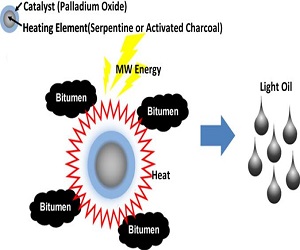
Adango Miadonye
Cape Breton University, Canada
Title: Microwave applications in petroleum processing
Biography
Biography: Adango Miadonye
Abstract
Statement of the Problem: Microwave energy is gradually becoming the most diverse form of energy transfer. It has been used with great success in the petroleum industry for inspecting coiled tubing and line pipe, measuring multiphase fl ow and the mobilization of asphaltic crude oil. Th ough its implications in petroleum applications are yet to be fully understood, the electromagnetic aspects of energy transfer between microwaves and other forms of matter are well comprehended in processes where microwave energy is used to eff ect a chemical or physical change. Th e depletion of conventional crude oil reserves is accompanied by growing economic demand for various types of fuel, giving more prominence to heavy oil and bitumen which deposits exceed light oil deposits by two orders of magnitude. In Canada, eff orts have been intensifi ed to develop microwave irradiation technology for in situ enhanced oil recovery of the country’s large deposits of bitumen and heavy oil. Of the estimated 30 billion barrels of heavy oil in place, about 26 billion barrels are considered unrecoverable using the current technology. Th e specifi c objectives were to study microwave process conditions that would aff ect the upgrading of heavy oil/bitumen to synthetic crude and achieve up to 50% desulphurization as well as obtain preliminary data on process design and economics.
Methodology & Theoretical Orientation: In a typical experiment, oil was mixed with one or more of additives and exposed to various dosages of microwave radiation at low pressure. Th e microwave reactor was constructed from a domestic microwave oven which was modifi ed to allow for the accommodation of a mixer, a device to monitor temperature and pressure in the reactor and interfaced with a desktop computer for data acquisition. Th e power level and irradiation intensity was at level high.
Findings: Results obtained with GC-MS showed evidence of fragmentation process in heavy oil/bitumen samples but, no signifi cant change in molecular structure for majority of the light crude oil samples aft er being subjected to microwave irradiation. Average
reduction in sulfur content of 16% and 39.4% were obtained for heavy oil and light oil respectively.

Conclusion & Significance: The work done so far showed strong indications for the microwave technology to be employed not only for hydrocarbon extractions but also for in situ upgrading and field upgrading of heavy oil and bitumen desulphurization of crude oil and future upgrading of coal and oil shale. Overall, the microwave technology presents the best alternative, economically and environmentally, to the existing technologies for enhanced oil recovery operations and processing.

